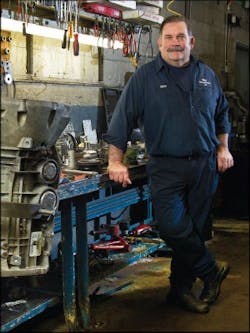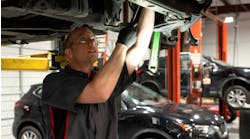After nine years of turning wrenches, Mike Sides took that terrifying leap and opened his own shop—Metro Transmissions Inc. in Columbus, Ohio.
For decades, he was in survival mode. No matter his staff size, pricing or amount of workflow, Sides at best could make ends meet.
“It seemed to sort of come and go, the good with the bad, as far as the influx of work went,” Sides says.
Fed up with treading water and motivated by a recent health scare, Sides sought help. In 2008, he began working with Educational Seminars Institute (ESI). Since then, Sides has made real changes in his shop, including a system for tracking technician productivity, an increased labor markup and detailed bookkeeping procedures, which have produced results.
On a good month, Sides will now double what he used to pull in, and he is consistently profitable at the end of the year.
In 2006, I had a heart attack, which put me out of commission for about four to six weeks. We were doing mediocre at the time. When I got back, I came to a realization where I decided things had to change.
On February first of 1982, we opened up Metro Transmissions. You know, the grass is always greener on the other side, until you actually get over there. The business end of it was a lot different. Instead of having everybody just give me a car, tell me to fix it, then they take care of the rest, it was a lot more work. I thought it was just going to be a piece of cake.
Business was up and down. We survived. We made ends meet.
We were feast or famine, like many businesses, for quite a long time.
Back in the late ’80s, I took a course on basic business, and I did learn quite a bit on different things I should be doing in my business as far as the work flow, proper repair order procedures, and doing a little bit of marketing off my computer.
I got my feet wet a little bit, got my eyes opened. I started doing some things better, but we still struggled. Where we would make money, we would lose money. At the end of the year, usually things would even out to where maybe you made a little bit, maybe you lost a little bit, but it was always more of a break-even type of thing. Things are much better now.
When I come in the morning, I will work on looking at my accounts. With the help of a consultant in 2009, I started walking through things that I do daily and started looking at statistics, so I can measure out performance and our productivity, looking at our costs and our expenses.
I got help getting the nuts and bolts end of the business down to a point where I can look at the statistics at the end of the week, and I can get a better snapshot for where we are.
One thing that I did have to do immediately was raise our labor rate. I think I was charging about $75 an hour labor. You know, sort of what everybody else is charging.
As I went through the process of inputting everything, I ended up finding out that we need a labor rate of $92.87 for us to get the profit that we want. Ideally, we are trying to get a five to ten percent net profit. So I changed that almost immediately within the first couple of weeks.
As we get into our major work, like for myself right now, I will typically have lined up which jobs are ready to be worked on.
One big change—a difficult change—for me was that I had a long-time employee of 26 years working for me as my transmission rebuilder. As I’ve worked over the past couple years, I was able to see who was productive and who was not. My long-term guy, he was very unproductive. I had to make a decision, and I ended up having to let him go last fall. It was very hard. After that long with someone like that, they’re really family.
I moved back to doing the rebuilding, after I lost my rebuilder. Our plan is that it is a temporary thing, but right now I’m sort of doing double duty.
Now I have two of my sons working in the business. My younger son works up front. He doesn’t like working on cars—he likes cars, just doesn’t like working on them. He prefers the business end. My older son works in the shop. He loves working on cars. I’m going to work on training him to do the rebuilding.
We try to meet once a week during our lunchtime. We’ll bring some pizza in or something, and we talk about what’s going on in the shop. What can we do better? What do we need to change?
Part of the plan for helping guys become more productive is to have an incentive-based program, which looks at the amount of billable hours that the guys are actually doing. Once they hit a certain level of efficiency, they get a bonus in their pay structure. We have found that their productivity has been going up, because they’re paying more attention to what they’re doing.
We try to get the guys to keep us in tune for what they do best. What jobs can they do fastest? And sometimes, we’ll even promote that particular kind of work.
The way I’ve been working in the back and building, if I get really busy, what I’ll usually do is try to do more of my bookwork after we’re done for the day. I might stay an hour or two after work, or I’ll just take it home and do it at home. So I can try to not get too far behind, but I do find myself getting further behind. I’m trying to get into a rhythm now to get a better system for not having to play catch-up all the time.
On a monthly basis, we used to typically do about $25,000 to $30,000 a month. If we were having a really good month, we might do $35,000. We hoped we made enough at the end of the week to pay our bills.
But the last few years, we’ve steadily bumped the numbers up to the point where we pretty consistently do $40,000 to $45,000 a month. We have done $60,000 to $65,000. So we’ve almost doubled what we did on a good month from before. It’s because of a combination of things. We’re more productive. We know the numbers we need for our hours. We know what we need to charge for parts. We know what our total jobs should be day-by-day, week-by-week, and we’re really able to have our goals set for what we need to achieve.
Our highest year we ever had, even when I had seven people working, was about $500,000. This year, even with the year being a sort of up-and-down year, we’re set where we should probably do pretty close to $600,000.
It seems like just taking care of the little things makes a tremendous amount of difference. It’s really a great sense of freedom. It relieves a lot of frustration.



